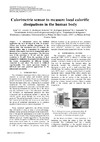Identificador persistente para citar o vincular este elemento:
https://accedacris.ulpgc.es/jspui/handle/10553/46299
| Título: | Calorimetric sensor to measure local calorific dissipations in the human body | Autores/as: | González De Chávez Menéndez, Jesús Socorro, F. Rodríguez De Rivera, M. Sarmiento Rodríguez, Roberto |
Clasificación UNESCO: | 3311 tecnología de la instrumentación | Palabras clave: | Calorimetría | Fecha de publicación: | 2014 | Publicación seriada: | 20th IMEKO TC4 Symposium on Measurements of Electrical Quantities: Research on Electrical and Electronic Measurement for the Economic Upturn, Together with 18th TC4 International Workshop on ADC and DCA Modeling and Testing, IWADC 2014 | Conferencia: | 20th IMEKO TC4 Symposium on Measurements of Electrical Quantities: Research on Electrical and Electronic Measurement for the Economic Upturn, Together with 18th TC4 International Workshop on ADC and DCA Modeling and Testing, IWADC 2014 | Resumen: | A calorimetric sensor for medical application has been developed in order to measure surface and localized calorific dissipations in the human body. The instrument tries to evaluate the calorific power that is transmitted by conduction, through a thermopile, between the human body and a thermostat at a constant temperature. The detection area of the prototype is 36 cm2 and the sensor resolution is 50 mW. From the equations of heat transport by conduction, we propose a model based on the sensor decomposition in different domains connected to each other. The model is validated experimentally. The sensor operation domain is indicated and some practical applications to the human body are shown. | URI: | https://accedacris.ulpgc.es/handle/10553/46299 | ISBN: | 9789299007327 | Fuente: | 20th IMEKO TC4 Symposium on Measurements of Electrical Quantities: Research on Electrical and Electronic Measurement for the Economic Upturn, Together with 18th TC4 International Workshop on ADC and DCA Modeling and Testing, IWADC 2014, p. 656-660 |
| Colección: | Actas de congresos |
Los elementos en ULPGC accedaCRIS están protegidos por derechos de autor con todos los derechos reservados, a menos que se indique lo contrario.
